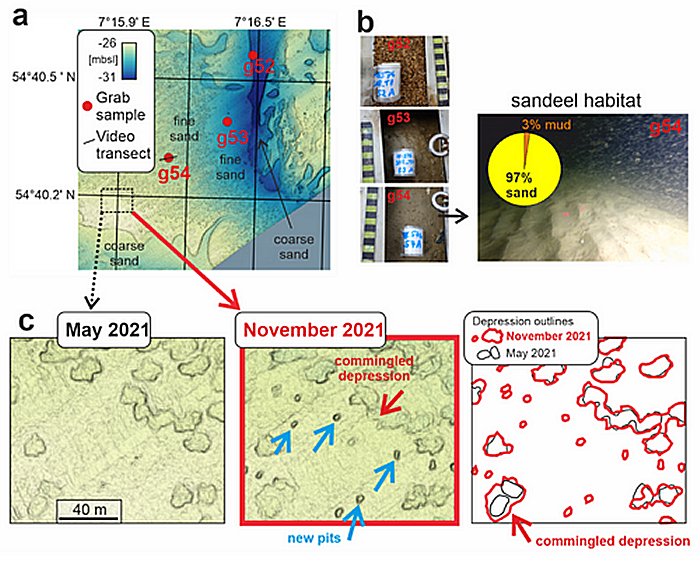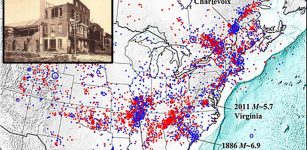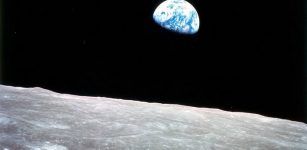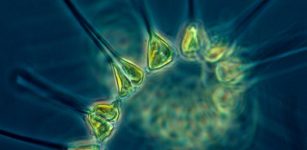Millions Of Mysterious Pits In The Ocean – Decoded
Eddie Gonzales Jr. – MessageToEagle.com – A team of geoscientists from Kiel University, together with colleagues from biology and oceanography, have examined crater-like depressions on the seafloor of the North Sea.
Overview map of the studied area in the German Bight of the North Sea: The red and yellow-dashed polygons outline the regions hosting the seafloor depressions. Image credit: Schneider von Deimling, Hoffmann, Geersen et al. (2023), Commun Earth Environ
They showed that these directly relate to the habitats of porpoises and sand eels, and for the first time provide a conclusive explanation for the importance of vertebrates in shaping the seafloor.
Pockmarks – thousands of crater-like depressions in the sediment cover the North Sea seafloor, but not only this region of the globe. There are probably millions of them around the world ocean. According to common scientific understanding, they are formed by fluid discharge such as the greenhouse gas methane or groundwater.
The majority of these pockmarks still puzzle researchers today, as many cannot be explained by fluid seepage.
“Our results show for the first time that these depressions occur in direct connection with the habitat and behavior of porpoises and sand eels and are not formed by rising fluids”, says Dr Jens Schneider von Deimling, lead author of the current study and geoscientist at Kiel University, in a press release.
“Our high-resolution data provide a new interpretation for the formation of tens of thousands of pits on the North Sea seafloor, and we predict that the underlying mechanisms occur globally, but have been overseen until now”, Schneider von Deimling adds.
Researchers examined the seafloor in the North Sea off Heligoland down to centimeters. They also included the behavior of vertebrates such as porpoises in their analyses.
“From analyses of the stomach contents of stranded porpoises, we know that sand eels are an important food source for the North Sea population”, says Dr Anita Gilles of the TiHo-Institute for Terrestrial and Aquatic Wildlife Research (ITAW), who has long studied the biology of marine mammals.
Most of the depressions in the seafloor in the German Bight, the team suspects, are created by porpoises and other animals in search of food, and then scoured out by bottom currents. The sand eel, a small eel-like fish that spends most of the year buried in shallow sediments, plays a key role in this process. Sand eels are not only popular with the fishing industry, but are also consumed in large quantities by porpoises.
In their study, the researchers showed that the marine mammals leave pits in the seafloor when they hunt for buried sand eels. Although these pits resemble the familiar pockmarks, they are much shallower.
Advanced multibeam echosounder technology provides information on pit condition
The detection of the pits has only become possible in recent years with the help of modern multibeam echosounder technology, which is taught and practiced intensively at Kiel University.
“The formation mechanism of these pits, as we call them, probably also explains the existence of numerous crater-like depressions on the seafloor worldwide, which have been misinterpreted as the result of methane gas leaks”, says geoscientist Schneider von Deimling.
Repeat measurements in the study area highlight the development of seafloor pits in a sandeel habitat between May and November 2021. © Schneider von Deimling, Hoffmann, Geersen et al. (2023), Commun Earth Environ
In the North Sea, the researchers identified 42458 of these enigmatically shaped, shallow pits with an average depth of just eleven centimeters, which differ in their morphology from the more conical craters of the pockmarks.
For the study, Schneider von Deimling and researchers from the Alfred Wegener Institute, the Helmholtz Centre for Polar and Marine Research (AWI), the University of Veterinary Medicine Hannover, Foundation (TiHo) as well as the Leibniz Institute for Baltic Sea Research Warnemünde (IOW)
The results were published today on December 19th in the journal Communications Earth & Environment.
Schneider von Deimling, J., Hoffmann, J., Geersen, J., Koschinski, S., Lohrberg, A., Gilles, A., Belkin, I., Böttner, C., Papenmeier, S., Krastel, S.: Millions of seafloor pits, not pockmarks, induced by vertebrates in the North Sea. Commun Earth Environ (2023). DOI: 10.1038/s43247-023-01102-y
Written by Eddie Gonzales Jr. – MessageToEagle.com Staff Writer












